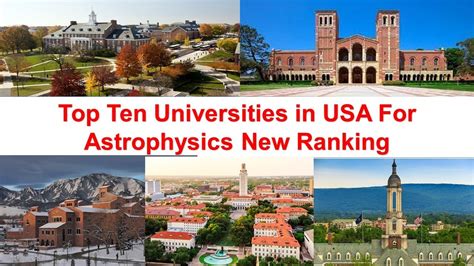Are you fascinated by the mysteries of the universe and eager to unravel its secrets? If so, a career in astrophysics may be the perfect fit for you. In this blog post, we will be delving into the astrophysics programs offered by the top universities in the United States. From understanding the program curriculum to exploring research opportunities, faculty expertise, and admission requirements, we will cover everything you need to know about pursuing a degree in astrophysics. We will also discuss the practical experience options available for students, the cutting-edge research projects in the field, career prospects for graduates, and the networking and collaboration opportunities that come with studying astrophysics. With access to advanced facilities and astronomical observatories, these programs offer an immersive and comprehensive experience for aspiring astrophysicists. Let’s decode the universe together and uncover the endless possibilities that await in this captivating field.
Table of Contents
Understanding the astrophysics program curriculum
When it comes to understanding the astrophysics program curriculum, it is essential to grasp the foundational concepts and the advanced topics that will be covered throughout the program. The curriculum is designed to provide students with a comprehensive understanding of the principles of astrophysics, including celestial mechanics, electromagnetic radiation, and the structure and evolution of stars and galaxies.
As students progress through the program, they will delve into more specialized areas such as cosmology, high-energy astrophysics, and observational techniques. Hands-on experience with telescopes, spectrographs, and other cutting-edge astronomical instruments is often integrated into the curriculum to give students practical exposure to the field.
Additionally, courses on computational astrophysics and data analysis play a crucial role in equipping students with the necessary skills to analyze and interpret complex astrophysical phenomena. The program curriculum also emphasizes the importance of interdisciplinary knowledge, covering relevant areas such as physics, mathematics, and computer science.
Overall, an in-depth understanding of the astrophysics program curriculum is essential for students to prepare themselves for a successful and fulfilling career in the field of astrophysics.
Exploring the research opportunities in astrophysics
When exploring the research opportunities in astrophysics, it’s important to consider the wide range of projects and studies that are available to students and researchers in this field. From studying the formation of galaxies to understanding the behavior of black holes, there are countless avenues for research in astrophysics.
One of the key areas of research in astrophysics is the study of exoplanets, which are planets that exist outside of our solar system. Researchers in this field are constantly working to discover new exoplanets and understand their composition and potential habitability. This research has the potential to expand our understanding of the universe and the possibility of life beyond Earth.
Another exciting area of research is the exploration of dark matter and dark energy, which are two of the most enigmatic components of the universe. Astrophysicists are working to develop new theories and experiments to better understand these phenomena, which could have far-reaching implications for our understanding of the cosmos.
Overall, the research opportunities in astrophysics are diverse and exciting, offering students and researchers the chance to explore some of the most profound mysteries of the universe.
Faculty expertise and their contributions to the field
When it comes to studying astrophysics, having the guidance and mentorship from experienced faculty members is of utmost importance. The faculty expertise in this field plays a crucial role in shaping the learning experience and providing students with valuable insights. From theoretical astrophysicists to observational astronomers, the diverse backgrounds and research interests of the faculty members contribute to a rich and comprehensive learning environment.
Many faculty members are actively involved in groundbreaking research projects, pushing the boundaries of our understanding of the universe. Their contributions to the field are not only impactful in terms of academic publications and discoveries, but also in inspiring and mentoring the next generation of astrophysicists. Their expertise and dedication create an environment where students can engage in meaningful discussions, collaborate on research endeavors, and gain hands-on experience in the field.
As students explore the various subfields of astrophysics, they benefit from the diverse expertise of the faculty members. Whether it’s studying the formation of galaxies, researching exoplanets, or delving into the mysteries of black holes, students have the opportunity to work closely with faculty members who are leading authorities in their respective areas of expertise.
Furthermore, the contributions of faculty members extend beyond the academic realm. They are often involved in public outreach programs, sharing their passion for astrophysics with the wider community and inspiring future scientists. Their dedication to both the academic and public spheres demonstrates the far-reaching impact of their expertise and contributions to the field.
Internship and practical experience options for students
Securing an internship in the field of astrophysics can be a crucial step towards gaining practical experience and expanding one’s knowledge. Students can seek internships at various institutions, including research organizations, space agencies, and astronomical observatories. These internships provide an opportunity to work alongside experienced astronomers and astrophysicists, gaining hands-on experience in data analysis, telescope operations, and astronomical research.
Furthermore, students can also explore practical experience options through participation in collaborative research projects with faculty members. Involvement in these projects allows students to immerse themselves in the research process, from formulating hypotheses to presenting findings at conferences or in academic journals. This firsthand experience not only enhances their skills but also contributes to the advancement of knowledge in the field of astrophysics.
Additionally, some universities offer cooperative education programs that integrate periods of academic study with professional work experiences. These programs provide students with the opportunity to gain practical experience while earning credit towards their degree. By participating in co-op programs, students can develop a deeper understanding of astrophysics and establish valuable connections within the industry.
In conclusion, students pursuing a degree in astrophysics have a variety of options to gain practical experience through internships, research projects, and cooperative education programs. These opportunities not only complement their academic studies but also prepare them for future careers in the field of astrophysics.
Admission requirements and application process
When it comes to pursuing a degree in astrophysics, it’s important to understand the admission requirements and application process. The first step in this journey is to ensure that you meet the academic prerequisites. Strong mathematics and physics backgrounds are essential, as well as a solid foundation in computer science and chemistry.
Once you have secured the necessary academic credentials, the next step is to submit a comprehensive application. This typically includes a personal statement, letters of recommendation, and your academic transcripts. In some cases, standardized test scores, such as the GRE, may also be required.
It’s crucial to demonstrate a genuine passion for astrophysics and a keen interest in research. Highlighting any relevant extracurricular activities, internships, or independent study projects can significantly enhance your application.
Finally, it’s important to familiarize yourself with the specific requirements of each institution you are applying to. Different universities may have unique criteria and application deadlines, so be sure to carefully review their admissions guidelines.
Diving into the cutting-edge astrophysics research projects
When it comes to astrophysics research projects, there are exciting developments happening all around the world. From studying black holes to exploring the mysteries of dark matter, cutting-edge research projects in astrophysics offer the opportunity to delve into some of the most intriguing and fundamental questions about the universe.
One of the most fascinating research projects in astrophysics involves the study of exoplanets. With the recent discovery of thousands of exoplanets outside our solar system, scientists and researchers are working tirelessly to understand the potential for habitable planets and the existence of extraterrestrial life.
Another area of cutting-edge research in astrophysics is the study of gravitational waves. The detection of these ripples in spacetime has opened up new avenues for exploration, including the ability to observe phenomena such as neutron star collisions and mergers of black holes.
Furthermore, astrophysics research projects often involve collaboration with other scientific disciplines, such as astronomy, cosmology, and particle physics. This interdisciplinary approach allows for a more holistic understanding of the universe and its underlying principles.
Breaking down the course structure and specializations
When studying astrophysics, it’s important to have a clear understanding of the course structure and the various specializations available to students. The curriculum typically includes a combination of theoretical courses, laboratory work, and research projects, allowing students to gain a comprehensive understanding of the field.
One of the key specializations in astrophysics is cosmology, which focuses on the study of the origins and evolution of the universe. Students specializing in cosmology may take courses in observational astronomy, theoretical astrophysics, and cosmological models.
Another specialization is stellar physics, which delves into the study of stars, their formation, evolution, and eventual demise. Students pursuing this specialization may take courses in stellar structure, nucleosynthesis, and compact objects.
Other specializations may include galactic dynamics, extragalactic astronomy, and planetary science, each offering a unique focus within the broader field of astrophysics.
Career prospects for astrophysics graduates
Graduating with a degree in astrophysics opens up a wide range of career opportunities for students. With a strong foundation in physics and astronomy, astrophysics graduates are well-equipped to pursue careers in research, academia, and industry.
Many graduates choose to continue their education by pursuing a PhD in astrophysics or a related field. This path can lead to opportunities for conducting groundbreaking research, publishing papers in academic journals, and teaching at the university level.
Alternatively, graduates may pursue careers in the science communication field, working as educators, writers, or media professionals to share their passion for astrophysics with the public. Other career options include working for government agencies, private research institutions, or space exploration companies.
Overall, the career prospects for astrophysics graduates are diverse and exciting, offering opportunities to make meaningful contributions to our understanding of the universe and to inspire the next generation of scientists.
Networking and collaboration opportunities in the field
One of the key factors for success in any career field is the ability to network and collaborate with peers and professionals in the industry. In the field of astrophysics, this is particularly important as it allows researchers and experts to share knowledge, exchange ideas, and work together on groundbreaking projects. Through networking and collaboration, aspiring astrophysicists can gain access to valuable resources, mentorship, and even potential job opportunities in the future.
Attending conferences, seminars, and workshops is a great way for astrophysics students and professionals to network with others in the field. These events provide opportunities to meet and connect with experts, researchers, and students from different institutions and backgrounds. Additionally, participating in collaborative research projects or joining professional organizations related to astrophysics can also open doors for networking and collaboration.
Online platforms and social media have also become essential tools for networking and collaboration in astrophysics. Websites, forums, and social media groups dedicated to the field provide a space for professionals and students to connect, share ideas, and seek advice. By actively engaging in online communities, individuals can build a strong network of contacts and stay updated on the latest developments and opportunities in astrophysics.
Furthermore, universities and research institutions often facilitate networking and collaboration opportunities for their students and faculty. They may organize events, seminars, and research symposiums where individuals can present their work, interact with peers, and form valuable connections within the astrophysics community. These platforms offer a conducive environment for collaboration, idea exchange, and potential partnerships in research endeavors.
Access to advanced facilities and astronomical observatories
When pursuing a degree in astrophysics, having access to advanced facilities and astronomical observatories is crucial for conducting research and gaining practical experience. Many universities and research institutions offer state-of-the-art facilities that provide students with the opportunity to explore the depths of space and contribute to groundbreaking discoveries.
Advanced facilities such as telescopes with cutting-edge technology enable students to observe celestial bodies and phenomena with exceptional clarity and precision. This hands-on experience is invaluable for students looking to delve into the field of astrophysics and develop their research skills.
In addition to telescopes, astronomical observatories provide students with the chance to collaborate with experienced astronomers and researchers. These collaborative opportunities allow students to gain insight into the process of astronomical data collection and analysis, as well as the chance to contribute to ongoing research projects within the field.
Access to advanced facilities and astronomical observatories also opens doors to networking and collaboration opportunities within the astrophysics community. By working alongside leading experts and utilizing cutting-edge equipment, students can expand their knowledge and contribute to the advancement of the field.





